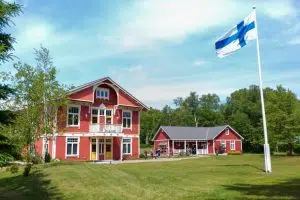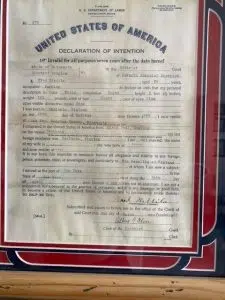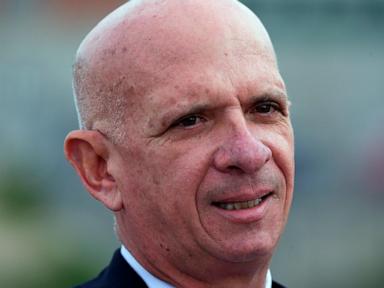
Photo: Salolampi Foundation
(KDLM) – The following article is part two of a five-part series by Zeke Fuhrman. In March, he set out to learn more about Finnish culture in West Central Minnesota, the impact of Finnish immigrants in the late 1800s and early 1900s, and, through interviews with community business leaders, learns what life was like growing up Finn.
My great-grandfather, Fred Nissila, immigrated from Finland in April 1906 and began work as a farmer in the Kensington area in Douglas County. Nearly 120 years later, my family still has roots in the Parkers Prairie, Miltona, and Brandon areas. One of my main objectives in researching this project was to find out what life was like for early Finn immigrants that were coming to America, where they went, and what they did.

A photo of my great-grandfather Frederick Nissila’s Declaration of Intention, which he filled out and signed on Ellis Island in April of 1906.
While I was at the Wild game on March 13th, I got connected with the Salolampi Finnish Language Village. Salolampi was the beneficiary of a $1,250 donation from the Minnesota Wild that night during their Finnish Heritage Night and was on hand on the plaza providing information on the Concordia College non-profit.
“Salolampi is one of about 15 different Concordia-based language villages,” Salolampi Foundation president John “Jussi” Hanson told me. “Salolampi is just outside of Bemidji on Turtle River Lake. In Finnish, salo means deep woods, and lampi means pond, so it means ‘pond in the deep woods.'”
Amy “Iida” Tervola Hultburg has been the camp dean at Salolampi since 2012 and had lots of information about the early history of Finnish immigrants.
“When the Finns first started coming to Minnesota, they originally settled in the Dassel-Cokato area before moving further north,” Tervola Hultburg told me. “They got jobs in the mines, they went and worked the farms…more gritty jobs that were less desirable. And a lot of them settled in what is called the Finnish Triangle…which isn’t really a triangle at all: Sebeka, Menahga, and New York Mills, and more of them settled further north to work the mines in the Crosby-Ironton area, and some of them went even further north to the Hibbing and Virginia areas, which is where the legend of St. Urho originated.”

Amy Tervola Hultberg (second from the right) and her family at Finnish Heritage Night at the Minnesota Wild game on March 13th.
“In the New York Mills/Sebeka/Menahga area, farming was the main occupation of the immigrant Finn,” says Tervola Hultburg. “Sometimes they would work the mines or shipping yards on the Iron Range or the Great Lakes for a week at a time, then come back for the farming. Logging was big too. Sawmills were a huge industry for the Finns. Logging is still a huge industry in Finland today. In 2018, Finland’s first lady Jenni Haukio wore a dress made from wood fibers to celebrate Finland’s Independence Day. Those were three of the large industrial impacts that Finnish immigrants had in those early days: farming, mining, and logging.”
I also learned a lot about the experiences students receive at the Salolampi Village: everything from taking a sauna by the lake, to eating authentic Finnish food, staying in traditional Finnish cabins, and even a currency exchange for your gift shop spending money to learn how to count Finnish currency (the Euro).
“One of the things that makes Salolampi special is that it’s a combination of language and culture,” said Hanson. “The village has cabins where people stay and the main lodge where people eat and host big events. All of the outdoor buildings match Finnish architecture. There is a big sauna by the lake and a tanssilattia a dance floor outside with a roof on it. There are places to play football (soccer) and floor hockey, which are Finland’s two biggest sports.”
A typical day for Salolampi campers includes a morning and an afternoon language class, two club activities, and a large group activity in the late afternoon that usually consists of a team sport, game, music, or art project.
“Another fun part of Salolampi is the naming process,” says Amy “Iida” Tervola Hultberg, who has served as camp dean since 2012. “We all take on alternative, traditional names.”
And, of course, Salolampi campers eat authentic Finnish food at mealtimes.
“The Finns have had some culinary breakthroughs over the last couple of years,” said Tervola Hultberg. “Finns get a lot of their protein from grains and beans instead of meat, so they invented something called nyhtökaura, or pulled oats. Finns are really innovative when it comes to getting alternative proteins. Pulled oats are essentially oats, yellow pea proteins, fava beans, oil, and salt and it looks a lot like pulled pork. Finns, like many Europeans, are becoming more and more attuned to the fact that we eat a lot of meat, and are finding new ways to be more cognizant of what we eat. But of course, there are still the things like the blood sausage, the cardamom bread, and rice pies. It’s not a very voracious palate as far as spice goes.”
“Finnish desserts, however, are very berry-based. Finns also love their ice cream. Finnish ice cream always has to have a certain percentage of fat. Fresh cream, and not as much sugar as American ice cream has.”
You can find more information about the Salolampi Finnish Language Villiage here.
Part Three of our five-part Finnish Heritage series will feature Irene’s Favorite Things of Park Rapids and some of the authentic Finnish crafts, dinnerwear, sweets, and decorations you can find there.
Other Finnish Heritage Articles:
Finnish Heritage, Part 1: The Minnesota Wild Hold Finnish Heritage Night

Latest News




